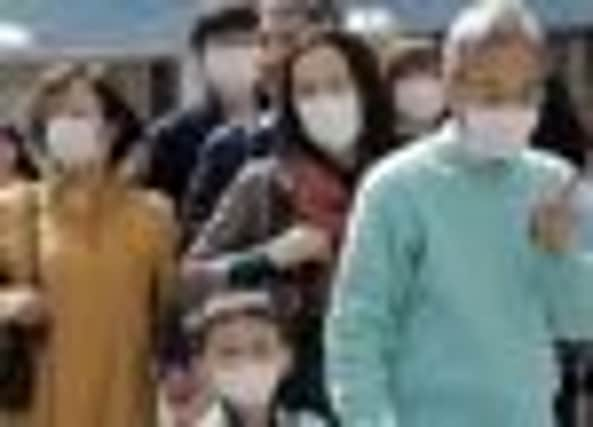Masks in Japan down to pollen, pollution and germs


The problem is pollen and germs, as well as pollution from Japan’s rival across the waves, China.
Simple masks. Hi-tech masks. Scented masks. Masks in pink and purple. Yano Research Institute says it’s a 26 billion yen (£180 million) market. Industry leader, Kowa Company, says it plans to quintuple production this year.
Advertisement
Hide AdAdvertisement
Hide Ad“It seems about half the people outside are wearing masks now,” said businessman Masahiko Haneda, whose boss has warned him to wear a mask at work whenever he catches a cold.
The main reason for the face coverings, however, is hay fever. Japan’s pollen levels are five times higher than they were last spring, due to a hot summer last year and a sudden spike in temperatures this month that has caused Japanese cedar and hinoki cypress trees – the worst culprits – to release their pollen all at once.
“The pollen is really bad this year,” said Takeshi Nunomura, who said he coughs constantly at night and cannot sleep if he doesn’t wear a mask during the day.
Germs are another reason. When Japanese people catch a cold, they often wear masks to keep from coughing or sneezing on others in tightly packed trains and in the office. And some perfectly healthy people wear masks to stop themselves inhaling those germs.
This year, there’s the added alarm about tiny particles of pollution called PM2.5, which are less than 2.5 microns in size, or about one thirtieth the width of a human hair, and can penetrate deep into the lungs. While the environment ministry says the level of PM2.5 particles is about the same as last year, the media has played up the dangers and noted that much of the pollution is coming from China. This has helped drive consumer demand for the masks.
“They say a lot of these masks can’t block those tiny particles, but it makes me feel better to wear it,” said Saori Takeuchi, a mask-clad Tokyo woman walking with her nine-year-old son, who is also wearing a mask. Drug stores display dozens of types of masks, with many claiming to “keep out 99 per cent” of pollen, germs and dust.
Sendai-based mask maker Iris Ohyama Incorporate says sales are double last year’s.
N95-type masks specifically designed to block out PM2.5 are harder to find than other masks and rather expensive, running about 400 to 500 yen (£2.80-£3.50) for just one. But mask manufacturers are rushing to produce them and reduce the cost.
Advertisement
Hide AdAdvertisement
Hide AdMask makers have come up with several variations. There are masks designed to fit snugly around the nose so they don’t fog up spectacles, and masks that can be taped directly to the cheeks. Iris Ohyama offers scented masks, in peppermint, rose menthol, grapefruit and lime/orange.
Some pollen-control devices aren’t masks at all. They comprise small plugs with nets in them that the user pops in their nostrils. There’s a cream and a spray, and one company sells a small bag of chemicals to be worn like a necklace and is supposed to form a bubble of pollen control around the user.
Masks are popular in Japan because they’re a cheap, easy way to keep pollen from entering the nose and causing an allergic reaction, says Shigeharu Fujieda, an allergy specialist at Fukui University. “For that purpose, masks are very effective. It’s cheap and safe. It seems to fit the thinking of many Japanese,” he said.
While Fujieda said he wasn’t particularly worried about Chinese pollution, he did say it could exacerbate hay fever by continuing to irritate noses after pollen levels decline.
The portion of Japanese who suffer hay fever has grown to a third from a tenth 30 years ago. The reasons aren’t clear. The increase in pollen from Japanese cedar trees – many planted after the war to increase greenery – is one factor, while diet may be another, experts say.
Lately, children as young as five have been developing hay fever, Fujieda said. In the past, the earliest that children would develop symptoms was in their early teens, he said.
Global warming seems to be playing a role in pollen production, said Norio Sahashi, director of the Association of Pollen Information in Narashino, Chiba prefecture. Generally hotter summers are causing the trees to produce more pollen cones, he said. As the aggravation of hay fever has grown, masks have become part of everyday Japanese life.
Elevator salesman Yoshifumi Yamamoto has been wearing masks for the first four months of the year for 20 years, mostly to protect against pollen and cold germs. He takes his mask off when meeting customers for the first time, but generally wears it the rest of the time.
“Customers don’t seem to have any problems with it,” he said. “Everyone knows it’s hay fever season.”